

Logical harmony. Logical harmony, a name coined by Sir Michael Dummett, is a supposed constraint on the rules of inference that can be used in a given logical system.

The logician Gerhard Gentzen proposed that the meanings of logical connectives could be given by the rules for introducing them into discourse. For example, if one believes that the sky is blue and one also believes that grass is green, then one can introduce the connective and as follows: The sky is blue AND grass is green. Gentzen's idea was that having rules like this is what gives meaning to one's words, or at least to certain words. Gödel's incompleteness theorems. Gödel's incompleteness theorems are two theorems of mathematical logic that establish inherent limitations of all but the most trivial axiomatic systems capable of doing arithmetic.
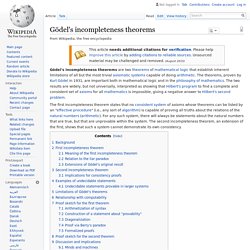
The theorems, proven by Kurt Gödel in 1931, are important both in mathematical logic and in the philosophy of mathematics. The two results are widely, but not universally, interpreted as showing that Hilbert's program to find a complete and consistent set of axioms for all mathematics is impossible, giving a negative answer to Hilbert's second problem. The first incompleteness theorem states that no consistent system of axioms whose theorems can be listed by an "effective procedure" (i.e., any sort of algorithm) is capable of proving all truths about the relations of the natural numbers (arithmetic).
For any such system, there will always be statements about the natural numbers that are true, but that are unprovable within the system. Background[edit] Tarski's undefinability theorem. Tarski's undefinability theorem, stated and proved by Alfred Tarski in 1936, is an important limitative result in mathematical logic, the foundations of mathematics, and in formal semantics.

Informally, the theorem states that arithmetical truth cannot be defined in arithmetic. The theorem applies more generally to any sufficiently strong formal system, showing that truth in the standard model of the system cannot be defined within the system. History[edit] In 1931, Kurt Gödel published his famous incompleteness theorems, which he proved in part by showing how to represent syntax within first-order arithmetic. Principle of bivalence. Law of excluded middle. In logic, the law of excluded middle (or the principle of excluded middle) is the third of the three classic laws of thought.
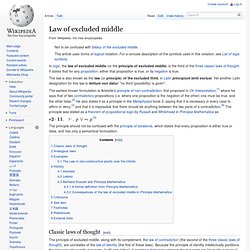
It states that for any proposition, either that proposition is true, or its negation is true. The law is also known as the law (or principle) of the excluded third, in Latin principium tertii exclusi. Yet another Latin designation for this law is tertium non datur: "no third (possibility) is given". Anti-realism. Anti-realism in philosophy[edit] Michael Dummett[edit] , without being able to produce any term of which holds.
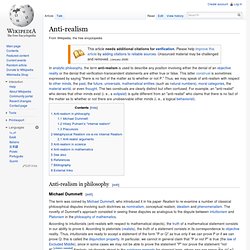
Instrumentalism. In the philosophy of science, instrumentalism is the view that a scientific theory is a useful instrument in understanding the world.

A concept or theory should be evaluated by how effectively it explains and predicts phenomena, as opposed to how accurately it describes objective reality. Instrumentalism avoids the debate between anti-realism and philosophical or scientific realism. It may be better characterized as non-realism. Instrumentalism shifts the basis of evaluation away from whether or not phenomena observed actually exist, and towards an analysis of whether the results and evaluation fit with observed phenomena.
Explanation[edit] Historically, science and scientific theories have advanced as more detailed observations and results about the world have been made. Instrumentalism is particularly popular in the field of economics, where researchers postulate fictional economies and actors. An instrumentalist position was put forward by Ernst Mach. Intuitionistic type theory. Intuitionistic type theory (also known as constructive type theory, or Martin-Löf type theory) is a type theory and an alternative foundation of mathematics based on the principles of mathematical constructivism.
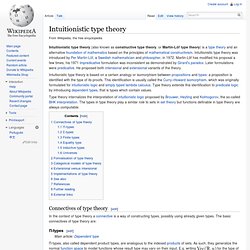
Intuitionistic type theory was introduced by Per Martin-Löf, a Swedish mathematician and philosopher, in 1972. Martin-Löf has modified his proposal a few times; his 1971 impredicative formulation was inconsistent as demonstrated by Girard's paradox. Later formulations were predicative. He proposed both intensional and extensional variants of the theory. Intuitionistic type theory is based on a certain analogy or isomorphism between propositions and types: a proposition is identified with the type of its proofs.
Constructive analysis. In mathematics, constructive analysis is mathematical analysis done according to the principles of constructive mathematics.
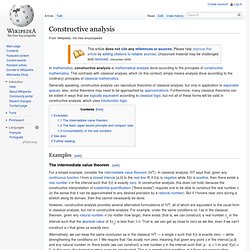
This contrasts with classical analysis, which (in this context) simply means analysis done according to the (ordinary) principles of classical mathematics. Constructive set theory. Disjunction and existence properties. Related properties[edit] Rathjen (2005) lists five properties that a theory may possess.
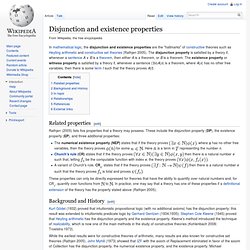
These include the disjunction property (DP), the existence property (EP), and three additional properties: These properties can only be directly expressed for theories that have the ability to quantify over natural numbers and, for CR1, quantify over functions from to . Background and History[edit] Kurt Gödel (1932) proved that intuitionistic propositional logic (with no additional axioms) has the disjunction property; this result was extended to intuitionistic predicate logic by Gerhard Gentzen (1934,1935). While the earliest results were for constructive theories of arithmetic, many results are also known for constructive set theories (Rathjen 2005). Most classical theories, such as Peano Arithmetic and ZFC do not have the existence or disjunction property.
Heyting algebra. It follows from the definition that 1 ≤ 0 → a, corresponding to the intuition that any proposition a is implied by a contradiction 0.
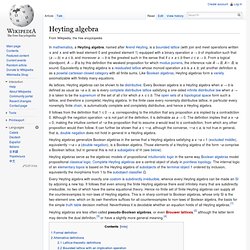
Intuitionistic logic. ("true" and "false" respectively) regardless of whether we have direct evidence for either case. In contrast, propositional formulae in intuitionistic logic are not assigned any definite truth value at all and instead only considered "true" when we have direct evidence, hence proof.
(We can also say, instead of the propositional formula being "true" due to direct evidence, that it is inhabited by a proof in the Curry-Howard sense.) Operations in intuitionistic logic therefore preserve justification, with respect to evidence and provability, rather than truth-valuation. Intuitionism. In the philosophy of mathematics, intuitionism, or neointuitionism (opposed to preintuitionism), is an approach where mathematics is considered to be purely the result of the constructive mental activity of humans rather than the discovery of fundamental principles claimed to exist in an objective reality.
That is, logic and mathematics are not considered analytic activities wherein deep properties of objective reality are revealed and applied but are instead considered the application of internally consistent methods used to realize more complex mental constructs, regardless of their possible independent existence in an objective reality. Truth and proof[edit] To an intuitionist, the claim that an object with certain properties exists is a claim that an object with those properties can be constructed. Any mathematical object is considered to be a product of a construction of a mind, and therefore, the existence of an object is equivalent to the possibility of its construction. L.E.J.